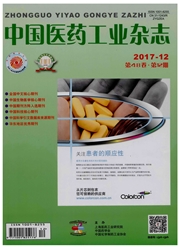

 中文摘要:
中文摘要:
构建了基于表面分子印迹技术的抗幽门螺杆菌(Helicobacter pylori)生物黏附纳米粒。以长链脂肪酸修饰的H.pylori表面抗原片段NQA为模板分子,利用反相微乳液聚合法制备表面分子印迹纳米粒,并用以包载5-羧基荧光素。选择H.pylori标准株SS1为细菌模型,采用流式细胞仪考察纳米粒与活菌的相互作用;为模拟细菌在体内的分布状况,建立了细菌-AGS细胞黏附模型,采用荧光显微镜观察纳米粒与模型的相互作用。结果显示,表面分子印迹纳米粒能通过识别H.pylori上的靶位点,在体外成功实现对H.pylori的特异性结合。
 英文摘要:
英文摘要:
Exploratory work was carried out in an effort to fabricate surface molecularly imprinted nanoparticles (MIPs) with specific recognition of Helicobacter pylori. The imprinted nanoparticles loaded with 5-carboxyfluorescein (FAM) were prepared via the inverse microemulsion polymerization method. The hydrophilic peptide template, abbreviated as NQA, an outer membrane protein of H. pylori, was modified with a long-chain fatty acid to assist in its localization on the surface of the nanoparticles upon polymerization. The in vitro interaction between MIPs and H. pylori was investigated via flow cytometry with H. pylori strain SS1 as bacterial model. An adhesion model of strain SS1 and AGS cells was established for better simulating the in vivo distribution ofH. pylori. The interaction between nanoparticles and the adhesion model was investigated by fluorescence microscopy. The results indicated that MIPs could specifically recognize the targeting point of H. pylori to realize the specific binding to H. pylori in vitro.
 同期刊论文项目
同期刊论文项目
 同项目期刊论文
同项目期刊论文
 期刊信息
期刊信息
